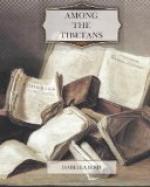On my arrival few of the shops in the great place, or bazaar, were open, and there was no business; but a few weeks later the little desert capital nearly doubled its population, and during August the din and stir of trade and amusements ceased not by day or night, and the shifting scenes were as gay in colouring and as full of variety as could be desired.
Great caravans en route for Khotan, Yarkand, and even Chinese Tibet arrived daily from Kashmir, the Panjab, and Afghanistan, and stacked their bales of goods in the place; the Lhassa traders opened shops in which the specialties were brick tea and instruments of worship; merchants from Amritsar, Cabul, Bokhara, and Yarkand, stately in costume and gait, thronged the bazaar and opened bales of costly goods in tantalising fashion; mules, asses, horses, and yaks kicked, squealed, and bellowed; the dissonance of bargaining tongues rose high; there were mendicant monks, Indian fakirs, Moslem dervishes, Mecca pilgrims, itinerant musicians, and Buddhist ballad howlers; bold-faced women with creels on their backs brought in lucerne; Ladakis, Baltis, and Lahulis tended the beasts, and the wazir’s jemadar and gay spahis moved about among the throngs. In the midst of this picturesque confusion, the short, square-built, Lhassa traders, who face the blazing sun in heavy winter clothing, exchange their expensive tea for Nubra and Baltistan dried apricots, Kashmir saffron, and rich stuffs from India; and merchants from Yarkand on big Turkestan horses offer hemp, which is smoked as opium, and Russian trifles and dress goods, under cloudless skies. With the huge Kailas range as a background, this great rendezvous of Central Asian traffic has a great fascination, even though moral shadows of the darkest kind abound.
On the second morning, while I was taking the sketch of Usman Shah which appears as the frontispiece, he was recognised both by the Joint Commissioner and the chief of police as a mutineer and murderer, and was marched out of Leh. I was asked to look over my baggage, but did not. I had trusted him, he had been faithful in his way, and later I found that nothing was missing. He was a brutal ruffian,




